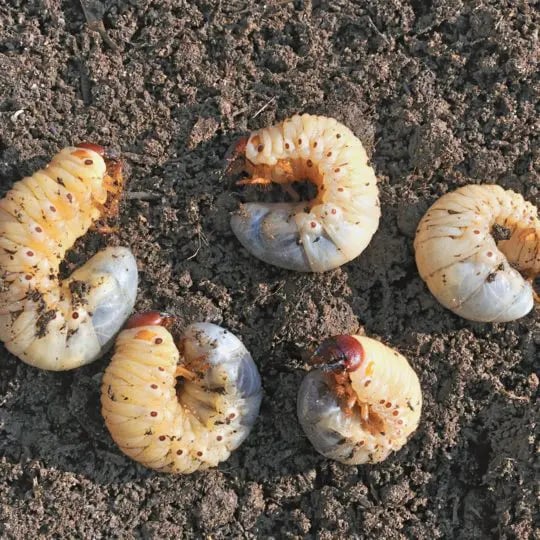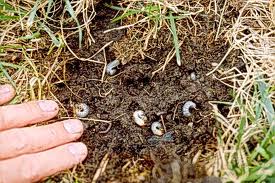Signs of Grubs on Lawn

Unlike the common earthworm, grubs (the larval form of various insects) are terrible for your lawn. They are most prevalent in summer when insects are plentiful and the moist grass of well-tended lawns provides an attractive site for them to lay their eggs. Learn to recognize signs of grubs on lawn and address the problem before they have the chance to make your lawn miserable.
Signs of Grubs on Lawn
You Have Brown Spots
Though summertime is a normal time to see brown spots forming in your lawn, these spots can be formed by underground grubs that have weakened the roots of the grass. This is an indication that you may have a grub problem but is not definitive.
There are many reasons you might have brown spots on your lawn. Visit our Lawn Library to discover other causes of these unhealthy patches.
Inspect for Grubs
Once you have noticed isolated brown patches and are wondering whether grubs are the culprit, finding out can be as easy as digging four inches down into the ground. If you find 10 or more pale, slimy-looking, c-shaped grubs within a single square foot, they are probably the cause of the browning of your lawn.
Feel for Soft Ground
Soft or spongy ground may indicate loose, root-stripped soil that grubs have been munching at. Unaffected areas will be tougher due to still being held together by the grass roots.
Test the Strength of the Grass
Grubs’ favorite food is grass roots. If the roots of your grass have recently been munched away, the grass may still look green (temporarily), but come out too easily when pulled.
Check for Signs of Animals
Wild animals find grubs delicious and will happily dig up your lawn under the cover of night to get at them. If you have a grub infestation, you may start to notice that your lawn is getting dug up by creatures like raccoons and skunks. Be sure that the dug up earth is not actually a molehill, as molehills are not an indication of the presence of grubs.

How to Handle Your Grub Problem
There a few things you can do yourself if you discover you do have grubs:
- Use Insecticides: Insecticides attack and kill grubs before they lay eggs and begin an infestation. Late summer and early fall are the times to apply insecticides to your lawn. Springtime should be avoided because grubs have stopped feeding by this time and spring rain washes the treatment away. Use insecticides with caution, as these chemical solutions can be dangerous if not used according to the manufacturer’s recommendations.
- Milky Spore: Milky spore can be applied to the areas of your lawn where grubs are feeding. As the grubs digest the spores, it infects and kills them. Then, as the grubs decompose, they release additional spores into the soil and infect the other grubs, preventing the infestation from spreading.
- Neem Oil: This oil-based pesticide is derived from Neem trees. Its insecticidal properties repel lawn grubs. Simply mix with water and apply spray treatments once a month during the summer. It works by preventing lawn grubs from laying eggs, growing, and feeding.
- Beneficial Nematodes: Instead of using chemicals, you can spray affected areas of your lawn with nematodes, which are soil-dwelling worms. Their bacteria infects and kills lawn grub populations.
Do these DIY solutions sound complicated? They can be. The easiest and most effective way to handle a grub problem is to call your local lawn pros at Green Lawn Fertilizing. We’ll come to take care of your grub infestation to help get your lawn back to health, and you don’t have to do a thing! Call us today at 888-581-5296 for more information.